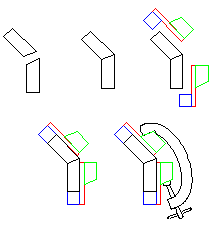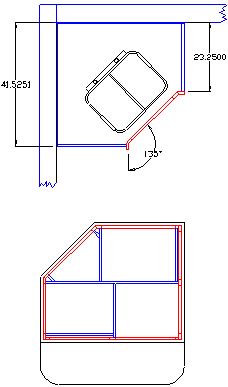Attaching Face Frames to Corner Cabinets
Approaches to angle transitions and tips on face frame assembly for corner cabinets. December 28, 2005
Question
Could you discuss your methods of construction for corner cabs and how you attach them to the face frame?
Forum Responses
(Cabinetmaking Forum)
From contributor G:
I dado the face frame stiles 3/4 wide, 1/4 deep, then cut 45 degree on the box side, then flip the side over, cut another 45 degrees. So the front edge of the side comes to a point. This allows the side to sit in the corner of the dado. Then glue and attach with pocket screws from the inside. The screws pull the side tight into the dado without clamps.
From contributor N:
I usually attach my face frames to the carcass. Do you want someone to detail how they build a corner cabinet from start to finish or is there something more specific you're after? If it is the prior, what kind of corner cabinet? There are many varieties.
From contributor F:
In regard to the face frame, I miter them at 22.5 degrees and using biscuits, I create a mitered left and right stile. This gives me an "ear" on both sides of the corner cabinet that falls in line with the straight runs of cabinetry on both sides. Doing it that way, I can cut my outside cabinet ends with square/90 degree edges and attach them to the outside stiles in the normal manner of any face frame cabinet.
From the original questioner:
Thanks for your input. I apologize for being so vague. I guess what I really wanted to do was start a general discussion on corner cabinet construction, especially the methods used to attach the face frame to the carcass. I've seen several jobs that have trim covering the transition from corner to straight line run of cabinets on the face frame (actually more often than not). I build mine in a manner that makes the trim unnecessary and believe it is the more professional way to do it.
From contributor F:
I hope you understood about my corner cabinet face frame method. This makes it possible to have a clean joint between the corner cabinet and the straight cabinets on either side that requires no moldings to hide a bad joint. It also enables you to attach the face frame to the cabinet without having to saw 45 degree edges on the corner cabinets side panels.
From contributor D:
I am assuming you are talking about a diagonal corner cabinet. If so, I cut the case sides to full depth. 45 the front edge, cut a .375 X .375 dado at the inside edge of the 45. The face frame is built .75 oversize with the stiles being .375 wider than what is to be exposed. The .375 X.375 rabbet is cut on the face side of the face frame to receive the face frame. I have a table saw dedicated to dados with a powerfeed. The milling is quick and the case is really easy to clamp this way. Square parts make square cabinets.
From contributor T:
I've done 20 or 30 cabs contributor F's way and used pocket holes to join them to the carcass. That method works well, except I looked for and never found a clamp to hold the two stiles together, which I would like better than just using tape, which is what I did. I've also 45° the carcass sides and used biscuits to join the ff to the carcass. That works well too. Contributor D's method sounds interesting, but I'm not certain I understand exactly what he's saying.
From contributor F:
Below is a drawing that shows a clamping jig I have used, and also varieties of this jig to clamp up the mitered stiles for corner cabinets. The drawing shows plan view only. The red base for the jig is .25" thick MDF and is held back from the corner to allow for glue squeeze out. The blue squares are hardwood and are glued and stapled on through the MDF. They are segmented in elevation view to bypass the top rail, drawer rail and bottom rail. On the jig that is applied to the ear of the mitered stiles, the blue rectangular hook runs the full length of the jig, and the jig runs the full length of the stiles. The green angled pieces are hardwood and run the full length of the jig. They are glued and stapled through the MDF. All angled parts are 22.5 degrees. The whole angle between the two stile sections is 45 degrees.
This jig idea can be adapted to clamp together stiles of other angles as well. Since I dowel and clamp my face frames together, it is easier and faster for me to miter the left and right stiles after the main face frame is glued together. I use the table saw blade tilted toward the fence method to saw the miters on the stiles. I saw miters on the two loose stiles at the same time. Also note that since the long point of these miters doesn't show in the finished cabinet, a guy could probably get a decent joint by countersinking a number of screws from that side of the miter. Also note that I use about four biscuits in mine for alignment purposes, not for strength.

Below are examples of mitered stile cabinets with inside 45 degree and outside 45 degree applications.

From contributor R:
Hope this helps.

Click here for full size image
From the original questioner:
Thanks. The pics were lots of help. What do you use for countertop fasteners? I didn't see any kind of support for that in the pic.
From contributor F:
I use stringers/stretchers all around on a corner cabinet, and front and back on a straight one. Those are shop drawings made for my eyes only, so I omit details that are standard.
From contributor V:
Kreg has some good information on how to do angled frames with pocket hole construction. I know their angle technique is shown in their advanced cabinetmaking with pocket hole construction flyer. This joint works well and is simple to cut on your tablesaw.


